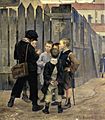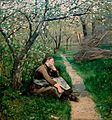Marie Bashkirtseff facts for kids
Quick facts for kids
Marie Bashkirtseff
|
|
|---|---|

Marie Bashkirtseff, 1878
|
|
| Born |
Maria Konstantinovna Bashkirtseva
12 November 1858 Gavrontsi, near Poltava, Russian Empire
|
| Died | 31 October 1884 (aged 25). Paris, France
|
| Cause of death | Tuberculosis |
| Resting place | Cimetière de Passy, Paris, France |
| Nationality | Russian |
| Citizenship | French, Russian |
| Occupation | Diarist, painter, sculptor |
| Known for | Journals and paintings |
|
Notable work
|
The Journal of Marie Bashkirtseff |
Marie Bashkirtseff (born Maria Konstantinovna Bashkirtseva, Russian: Мария Константиновна Башки́рцева; 1858–1884) was a talented Russian artist. She was also a famous diarist. Marie lived and worked in Paris, France. She sadly passed away at the young age of 25.
Contents
Marie Bashkirtseff's Early Life and Art Career
Marie Bashkirtseff was born Maria Konstantinovna Bashkirtseva. Her birth took place in Gavrontsi, a town near Poltava in the Russian Empire. This area is now part of Ukraine. She came from a very rich noble family. Her father, Konstantin Pavlovich Bashkitsev, was a local leader. Her mother, Maria Stepanovna Babanina, was also from a noble family.
Growing Up and Finding Her Passion
Marie's parents separated when she was 12 years old. Because of this, she spent most of her childhood traveling. She explored many parts of Europe with her mother. They lived for a while in Germany and on the Riviera. Eventually, her family settled in Paris, France.
Marie was taught at home and showed early talent in music. She hoped to become a singer. However, an illness damaged her voice, and she could no longer sing professionally. After this, she decided to become an artist. She began studying painting in France. She attended the famous Académie Julian.
Studying Art at the Académie Julian
The Académie Julian was special because it accepted female students. Many young women from Europe and the United States came to study there. Marie's classmates included Anna Bilińska-Bohdanowiczowa and Louise Breslau. Marie saw Louise Breslau as her main rival in art.
Marie created many impressive paintings in her short life. She showed her art at the Paris Salon, a famous art exhibition. She exhibited there every year from 1880 until her death, except for 1883.
Notable Artworks and Recognition
In 1884, Marie showed two important works. One was a portrait of children from Paris slums called The Meeting. The other was a pastel portrait of her cousin. She received an honorable mention for her work.
Marie Bashkirtseff's most famous paintings are The Meeting and In the Studio. The Meeting is now displayed in the Musée d'Orsay in Paris. In the Studio (1881) shows her fellow artists working. Sadly, many of Marie's artworks were destroyed during World War II. However, at least 60 of her paintings still exist today.
Art Style and Legacy
Marie was inspired by her friend Jules Bastien-Lepage. He admired realism and naturalism in art. Realism means showing things as they truly are. Naturalism focuses on showing nature and everyday life. While Bastien-Lepage painted nature, Marie chose to paint city scenes. She felt that the streets had not yet been fully explored by artists.
Both Marie and Bastien-Lepage became ill and passed away in the same year. Marie suffered from tuberculosis. She died at the age of 25. Despite her short life, she became an important intellectual figure in Paris. She even wrote articles for a feminist newspaper called La Citoyenne in 1881. She used the pen name "Pauline Orrel."
Marie Bashkirtseff passed away in Paris in 1884. She is buried in Cimetière de Passy in Paris. Her grave is a full-sized artist's studio. The French government has declared it a historic monument. Marie's work was also featured in the 2018 exhibit Women in Paris 1850-1900.
Marie Bashkirtseff's Famous Diary
Marie Bashkirtseff started keeping a journal when she was about 13 years old. This diary is what she is most famous for today. It is seen as a very modern and honest look into the mind of a young, talented person. Her writing is lively and easy to read.
A Window into 19th-Century Life
Marie could speak many languages. She was also a sharp observer of people and society. Her journal gives a detailed picture of the wealthy European families in the late 1800s. A main theme in her diary was her strong wish to become famous. She also wrote about her growing fear that her illnesses might be tuberculosis.
Near the end of her life, Marie wrote about her family history in her diary. She stated, "If I do not die young I hope to live as great artist; but if I die young, I intend to have my journal, which cannot fail to be interesting, published." She truly believed her life was remarkable and wanted it to be read after her death.
Publication and Impact of the Diary
Marie's journal was first published in 1887. It was only the second diary by a woman published in France at that time. It became very popular right away. Her diary was different from other diaries published before it.
An English translation of her diary came out two years later in 1889. It was called Marie Bashkirtseff: The Journal of a Young Artist 1860–1884. However, parts of it were removed or changed by her relatives. They wanted to take out anything they thought made the family look bad.
Influence on Other Writers
Many famous people admired Marie's diary. British Prime Minister William Gladstone called it "a book without a parallel." The writer George Bernard Shaw was also an early fan. The diary stayed popular and even inspired plays and movies about her life. One movie was The Affairs of Maupassant (1938).
American writer Mary MacLane said Marie's diary inspired her own honest journal. Other famous diarists like Katherine Mansfield and Anaïs Nin also mentioned it as a model. Marie's letters, including her writings to the author Guy de Maupassant, were published in 1891.
Discovering the True Story
For a long time, people thought Marie was born in 1860. But later, the original manuscript of her journal was found. It was discovered that her family had changed and shortened the first published versions. Her mother had even changed Marie's birth year to 1858, not 1860. This made Marie seem even more talented for her age. A full, unedited version of her journal has since been published in French.
Images for kids
See also
 In Spanish: María Bashkirtseff para niños
In Spanish: María Bashkirtseff para niños













